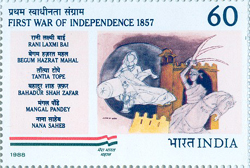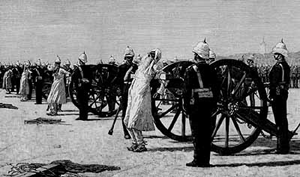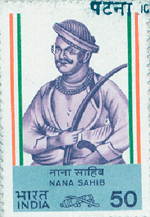
The Revolutionary Upheaval of 1857
Although dismissed by some as merely a sepoy’s mutiny or revolt, or as a protest against the violation of religious rights by the British, the great uprising of 1857 is slowly gaining recognition as India’s first war of independance. And in it’s broad sweep it was the greatest armed challenge to colonial rule during the entire course of the nineteenth century. Attracting people from all walks of life – both Hindus and Muslims, it triggered demands for radical social and economic reforms, calling for a new society that would be more democratic and more representative of popular demands.
Early Precedents
Neither was it a bolt out of the blue. Although not very well known, the period between 1763 and 1856 was not a period during which Indians accepted alien rule passively. Numerous uprisings by peasants, tribal communities and princely states confronted the British. Some were sustained – others sporadic – a few were isolated acts of revolutionary resistance – but nevertheless they all challenged colonial rule. Precipitated by the policy of unchecked colonial extraction of agricultural and forest wealth from the region – the period saw tremendous growth in rural poverty, the masses being reduced to a state of utter deprivation.

Even as official taxation was backbreaking enough, British officers routinely used their powers to coerce additional money, produce, and free services from the Indian peasants and artisans. And courts routinely dismissed their pleas for justice. In the first report of the Torture Commission at Madras presented to the British House of Commons in 1856, this was acknowledged along with the admission that officers of the East India Company did not abstain from torture, nor did they discourage its use. A letter from Lord Dalhousie to the Court of Directors of the East India Company confirms that this was a practice not confined to the Madras presidency alone in September 1855 where he admits that the practice of torture was in use in every British province.
Desperate communities had often no choice but to resist to the bitter end. Armed revolts broke out practically every year – only to be brutally suppressed by the British. Lacking the firepower of the British arsenal – they were invariably outgunned. And lacking the means of communication available to the British – individual revolts were also unable to trigger sympathetic rebellions elsewhere. Disadvantageous timing led to crushing defeats. Yet, some of these struggles raged for many years.

Amongst the most significant were the Kol Uprising of 1831, the Santhal Uprising of 1855, and the Kutch Rebellion, which lasted from 1816 until 1832. There was also precedence for a soldiers mutiny when Indian soldiers in Vellore (Tamil Nadu, Southern India) mutinied in 1806. Although unsuccessful, it led to the growth of unofficial political committees of soldiers who had several grievances against their British overlords.
Seething Grievances
For instance, in the Bengal Army, the 140,000 Indians who were employed as “Sepoys” were completely subordinate to the roughly 26,000 British officers. These sepoys bore the brunt of the First Britsh-Afghan War (1838-42), the two closely contested Punjab Wars (1845-6, and 1848-9) and the Second Anglo-Burmese War. They were shipped across the seas to fight in the Opium Wars against China (1840-42) and (1856-60) and the Crimean War against Russia (1854). Although at constant risk of death, the Indian sepoy faced very limited opportunities for advancement – since the Europeans monopolized all positions of authority.

Many of the sepoys in the Bengal Army came from the Hindi speaking plains of UP where (excluding Oudh) the British had enforced the “Mahalwari” system of taxation, which involved constantly increasing revenue demands. In the first half of the 19th century – tax revenues payable to the British increased 70%. This led to mounting agricultural debts with land being mortgaged to traders and moneylenders at a very rapid rate. This inhumane system of taxation was then extended to Oudh where the entire nobility was summarily deposed.
As a result, the dissatisfaction against the British was not confined to the agricultural communities alone. By bankrupting the nobility and the urban middle class – demand for many local goods was almost eliminated. At the same time local producers were confronted with unfair competition from British imports. The consequences of this were summarized by the rebel prince Feroz Shah, in his August 1857 proclamation: “the Europeans by the introduction of English articles into India have thrown the weavers, the cotton dressers, the carpenters, the blacksmiths and the shoe-makers and others out of employ and have engrossed their occupations, so that every description of native artisan has been reduced to beggary.”
Contrast this turn of events with the arrival of Mughal rule in India. Babar, in spite of his distaste for the Indian climate and customs, noted the tremendous diversity and skill of Indian craftspeople, and saw in that a great potential for expanding Indian manufacturing. Quite unlike the British, the Mughals built on the manufacturing strengths of the Indian artisan – (already well establish in the earlier Sultanate period) – and took them to dazzling heights in the later periods. But by the mid-19th century, this pre-industrial virtuosity in manufacturing had been virtually choked of by British policies. A British chronicler of the period, Thomas Lowe noted how ” the native arts and manufactures as used to raise for India a name and wonder all over the western world are nearly extinguished in the present day; once renowned and great cities are merely heaps of ruins…”

All this inevitably prepared the ground for the far more widespread revolt of 1857. Although concentrated in what is now UP in modern India – the 1857 revolt spread from Dacca and Chittagong (now Bangladesh) in the East to Delhi in the West. Major urban centres in Bengal, Orissa, and Bihar including Cuttack, Sambhalpur, Patna and Ranchi participated. In Central India – the revolt spread to Indore, Jabalpur, Jhansi and Gwalior. Uprisings also took place in Nasirabad in Rajasthan, Aurangabad and Kolhapur in Maharashtra and in Peshawar on the Afghan border. But the main battleground was in the plains of UP – with every major town providing valiant resistance to the British invaders.
Starting out as a revolt of the Sepoys – it was soon accompanied by a rebellion of the civil population, particularly in the North Western Provinces and Oudh. The masses gave vent to their opposition to British rule by attacking government buildings and prisons. They raided the “treasury”, charged on barracks and courthouses, and threw open the prison gates. The civil rebellion had a broad social base, embracing all sections of society – the territorial magnates, peasants, artisans, religious mendicants and priests, civil servants, shopkeepers and boatmen.
For several months after the uprising began in Meerut on May 10, 1857 – British rule ceased to exist in the northern plains of India. Muslim and Hindu rulers alike joined the rebelling soldiers and militant peasants, and other nationalist fighters. Among the most prominent leaders of the uprising were Nana Sahib, Tantia Tope, Bakht Khan, Azimullah Khan, Rani Laksmi Bai, Begum Hazrat Mahal, Kunwar Singh, Maulvi Ahmadullah, Bahadur Khan and Rao Tula Ram. Former rulers had their own grievances against the British, including the notorious law on succession, which gave the British the right to annexe, any princely state if it lacked “legitimate male heirs”.
Expressions of Popular Will
The rebels established a Court of Administration consisting of ten members – six from the army and four civilians with equal representation of Hindus and Muslims. The rebel government abolished taxes on articles of common consumption, and penalized hoarding. Amongst the provisions of it’s charter was the liquidation of the hated ‘Zamindari’ system imposed by the British and a call for land to the tiller.
Although the former princes who joined with the rebels did not go quite as far, several aspects of the proclamations issued by the former rulers are noteworthy. All proclamations were issued in popular languages. Hindi and Urdu texts were provided simultaneously. Proclamations were issued jointly in the name of both Hindus and Muslims. Feroz Shah – in his August 1857 proclamation included some significant points. All trade was to be reserved for Indian merchants only, with free use of Government steam vessels and steam carriages. All public offices were to be given to Indians only and wages of the sepoys were to be revised upwards.
Overpowered by British Might, Betrayed by the Princes
Threatened by such a radical turn of events, the British rulers poured in immense resources in arms and men to suppress the struggle. Although the rebels fought back heroically – the betrayal by a number of rulers such as the Sikh princes, the Rajasthani princes and Maratha rulers like Scindia allowed the British to prevail. Lord Canning (then Governor General) noted that ” If Scindia joins the rebels, I will pack off tomorrow”. Later he was to comment: ” The Princes acted as the breakwaters to the storm which otherwise would have swept us in one great wave”. Such was the crucial importance of the betrayal of the princes. The British were also helped by the conservatism of the trading communities who were unwilling to put up with the uncertanties of a long drawn out rebellion.
But equally important was the superior weaponry and brutality of the British in defending their empire. British barbarity in supressing the uprising was unprecedented. After the fall of Lucknow on May 8, 1858 Frederick Engels commented: ” The fact is, there is no army in Europe or America with so much brutality as the British. Plundering, violence, massacre – things that everywhere else are strictly and completely banished – are a time honoured privilege, a vested right of the British soldier..”. In Awadh alone 150,000 people were killed – of which 100,000 were civilians. The great Urdu poet, Mirza Ghalib wrote from Delhi, ” In front of me, I see today rivers of blood”. He went on to describe how the victorious army went on a killing spree – killing every one in sight – looting people’s property as they advanced.
Bahadur Shah’s three sons were publicly executed at “Khooni Darwaaza” in Delhi and Bahadur Shah himself was blinded and exiled to Rangoon where he died in 1862. Refusing to plead for mercy from the British, he courageously retorted: ” The power of India will one day shake London if the glory of self-respect remains undimmed in the hearts of the rebels”. Thomas Lowe wrote: “To live in India now was like standing on the verge of a volcanic crater, the sides of which were fast crumbling away from our feet, while the boiling lava was ready to erupt and consume us”
The 1857 revolt, which had forged an unshakable unity amongst Hindus and Muslims alike, was an important milestone in our freedom struggle – providing hope and inspiration for future generations of freedom lovers. However, the aftermath of the 1857 revolt also brought about dramatic changes in colonial rule. After the defeat of the 1857 national revolt – the British embarked on a furious policy of “Divide and Rule”, fomenting religious hatred as never before. Resorting to rumors and falsehoods, they deliberately recast Indian history in highly communal colors and practised pernicious communal politics to divide the Indian masses. That legacy continues to plague the sub-continent today. However, if more people become aware of the colonial roots of this divisive communal gulf – it is possible that some of the damage done to Hindu-Muslim unity could be reversed. If Hindus and Muslims could rejoin and collaborate in the spirit of 1857, the sub-continent may yet be able to unshackle itself from it’s colonial past.
Source : Indian History website archive
HJS Special

